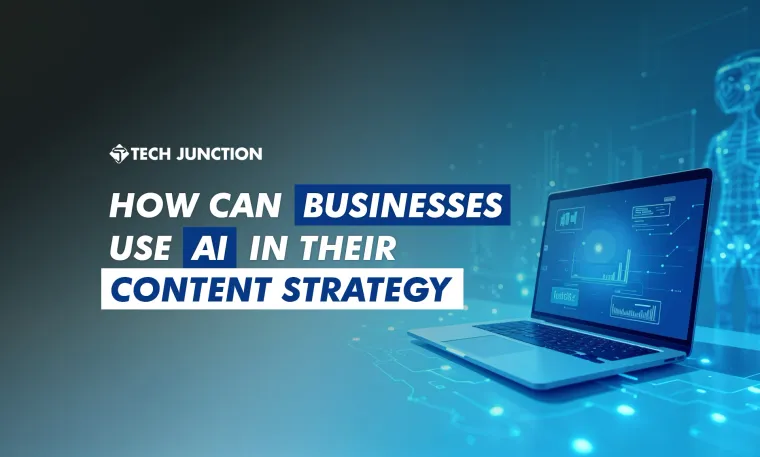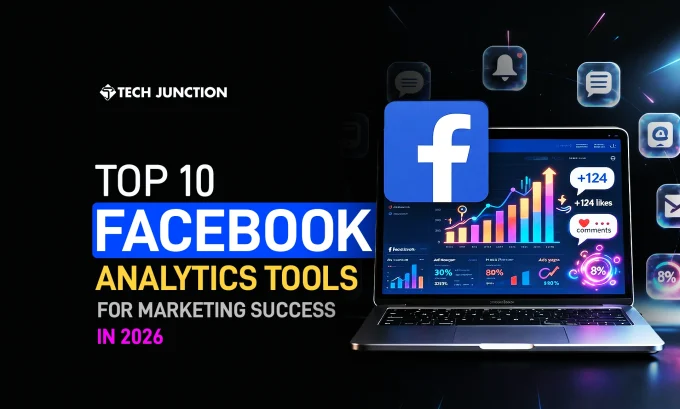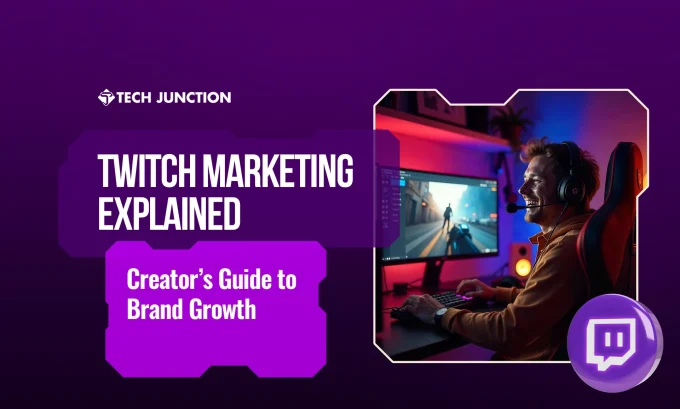AI is no longer a futuristic concept for content creation; it is already part of our lives and it is changing how content creators and businesses plan and produce content. This shift is driven by the ability of AI to offer efficiency, creativity, and better results. AI tools can generate ideas, draft copy, email, create images or videos, and even personalize content at scale. In this blog, we will share a simple AI content strategy and tools that businesses can use to improve their content. These tips will help you use AI effectively for content creation and marketing.
AI in Blogging and Long-Form Content
Blog posts and articles are the most important part of content strategy for many businesses, and AI is increasingly playing a role in content creation. Tools like OpenAI’s ChatGPT, Jasper.ai, Copy.ai, and Writesonic can help in AI in content creation, and we can quickly produce first drafts of articles or blog sections in a fraction of the time it would take a human to write from scratch.
AI can assist at various stages of blogging:
Brainstorming and Outlining:
When someone starts thinking about writing about a topic, it starts with brainstorming and AI can help you suggest blog topics. Not only does the topic suggest, but it also suggests on the basis of trending questions or keywords which can help to rank the topic. It can also generate detailed outlines, which are one of the most important parts of AI content marketing.
Drafting AI Content:
Many writers use AI to draft sections of the content. A common approach is to let the AI tool like ChatGPT or any other tool produce a draft and then a human writer edit and refine and proofread the AI written content. This “co-writing” can cut writing time while maintaining the quality of the content.
SEO Optimization:
Specialized AI tools like Surfer SEO, Frase, or MarketMuse analyze SEO data to help writers optimize content for search (suggesting keywords, headings, FAQs, etc.). Some AI writing platforms integrate these features, so you can make sure that your AI-generated draft is also SEO-friendly.
Editing and Proofreading:
AI-powered content editors (e.g., Grammarly or the built-in editing in tools like Jasper) can catch grammar issues, improve clarity, and even adjust tone. They act as a virtual copyeditor and also help to polish content before publication.
Related Article:
Top 10 Business Trends That Will Dominate 2025
AI in Social Media Content Creation
Social media moves fast and it is a must to be updated with the latest trends on every social platform, and AI is helping businesses keep up with a constant demand for fresh, engaging posts.
Here’s how businesses are applying AI content strategy creation and social media:
Generating Post Captions and Copy:
Crafting the perfect tweet or Instagram caption can be tedious. AI-driven content creation tools can suggest multiple variations of post text (for example, witty one-liners or informative descriptions) in seconds. For example, OwlyWriter AI of Hootsuite can generate post caption ideas based on a prompt or link you provide.
Creating Visuals:
Visual content is king on platforms like Instagram, Facebook, and Pinterest. AI image generators such as DALL·E, Midjourney, or Canva’s AI Image tools allow businesses to create custom images or graphics without a dedicated designer. For instance, a boutique can ask an AI to generate a stylized image of a product being used, to post on Instagram.
Hashtag and Trend Analysis:
Some AI tools analyze trending topics and hashtags relevant to your industry which can help you ride the wave of what’s popular. Tools like TrendHub or the built-in analytics of social platforms (often powered by AI algorithms) can recommend when and what to post for maximum impact.
Social Media Scheduling & Optimization:
Many standard social media management platforms (Buffer, Sprout Social, Later, etc.) now incorporate AI to optimize posting times and even suggest content. For example, Buffer’s AI Assistant can draft posts and suggest the best times to publish based on when your audience is most active.
AI for Video Content and Marketing
Video content is booming and video platforms like TikTok, YouTube, and Instagram Video (Reels) dominate consumer attention. However, producing high-quality videos has traditionally been resource-intensive and often required filming equipment, on-screen talent, and editing expertise. AI is changing that equation by lowering the barriers to video creation.
Key ways artificial intelligence is used in video AI-driven content strategy:
Script and Content Generation:
As we have already discussed that AI can write blog copy and it can draft video scripts or outlines. Marketers use tools like ChatGPT to generate video scripts for explainers, product demos, or even social media video captions. For example, if you want a 60-second promotional video script highlighting the benefits of your product or services, an AI tool can draft a coherent script that you can then tweak according to your requirements if needed.
AI-Generated Video Clips:
AI is growing so fast and till now the most groundbreaking AI tools for content marketing, like Synthesia, D-ID, and HeyGen, which can create videos from plain text. You can choose an AI avatar (a photorealistic human presenter) and a voice, paste your script, and the tool will produce a video of that avatar speaking your script in a realistic manner. This is incredibly useful for many things like you can use it to make tutorials, training videos, how-to content, or personalized sales videos etc.
Video Editing and Enhancement:
AI tools for content creation are also assisting in video post-production. For example, Descript can transcribe a video automatically and let you edit the video by editing text (cutting out filler words, etc.) which makes video editing as easy as editing a document. AI can upscale video quality, fix audio issues, or automatically add subtitles (which is crucial for social video engagement). If you have raw footage, AI editors can suggest the best cuts or create short highlight reels. There are tools like Pictory.ai and Lumen5 that take a blog post or text and generate a slideshow-style video with stock footage, animations, and text overlays, providing a quick way to turn written content into a video for platforms like YouTube or LinkedIn.
Personalization and Interactivity:
Some advanced AI video platforms allow personalization at scale. For example, an AI can generate thousands of video variations where the AI presenter speaks directly to individual customers by name or shows content tailored to them.
Related Article:
Top 5 Tech Business Trends to Watch in 2025
AI in Email Marketing and Personalization
Email marketing remains one of the highest ROI marketing channels, and AI is making it smarter and more efficient. Business owners, especially those with small teams, can use AI to automate and improve various aspects of their email campaigns.
Here are key applications of AI in email marketing and how businesses benefit:
Copywriting for Emails:
Writing effective marketing emails (newsletters, promotional blasts, or drip sequences) is time-consuming. AI writing tools can generate email copy or subject line ideas based on prompts. You can use tools like ChatGPT, Jasper, or Copy.ai. For example, you can prompt the AI with “Write a friendly promotional email offering a 20% discount on my new product to past customers” and it will draft a multi-paragraph email for you. Of course, you should tweak and align with your voice, but it provides a great starting point and it can save you from staring at a blank screen.
Subject Line Optimization:
Arguably, subject lines are the most critical part of an email (they largely determine open rate). AI has proven particularly adept at optimizing subject lines. There are dedicated tools like Phrasee and Persado that use AI to generate and test subject lines at scale. These systems analyze what language drives opens and can craft subject lines that appeal to emotions or curiosity.
Personalization and Segmentation:
Personalization goes beyond just “Hello [Name]”. AI can analyze customer data (past purchases, website behavior, email interactions) to create micro-segments and even craft dynamic content blocks within emails that differ per recipient. For example, an e-commerce store might use AI to automatically recommend products in an email that are tailored to each shopper’s browsing history.
Getting Started with AI Content Strategy: Tips for SMEs
Here’s a practical guide to help business owners begin using AI for content creation and marketing:
Start Small with Brainstorming and Outlines:
If you’re new to AI, a great first step is using it for idea generation. Feed an AI tool a prompt about your industry or ask it questions to generate blog post ideas, social media topics, or email campaign themes. For example, “What are some common questions [my target audience] asks about [my product]?” The AI’s suggestions can jump-start your content calendar.
Choose the Right Tools (and Use Free Trials):
There are dozens of AI tools out there, so pick ones that fit your specific needs. If writing is your pain point, try a copywriting AI like Jasper or Copy.ai. If you struggle with social media consistency, an AI-driven scheduler like Lately or Buffer can be useful. Need videos but lack resources? Experiment with Synthesia or Lumen5. Many of these tools have free versions or trial periods – take advantage of those to see what works for your workflow.
Train and Tweak the AI:
AI tools often allow you to provide input that guides their output. When using a writing AI, provide as much context as possible (e.g., tell it your target audience, the tone you want – friendly, professional, humorous, etc., and the goal of the content). The more specific your prompt, the better the result. Small details help the AI produce content closer to what you envision. Over time, you’ll learn how to speak to the AI (“prompt engineering”) to get useful drafts consistently.
Always Review and Edit (Human Touch is Non-Negotiable):
Think of AI as your first draft assistant, not your final copywriter. As the stats showed, 93% of marketers using AI have humans review and edit the content before publishing.
This is critical. You need to check facts and make sure that the tone and style match your brand, and inject real examples or stories that AI might not know.
Editing also helps avoid any embarrassing errors (AI might inadvertently use an outdated statistic or misstate something about your business). The good news is, editing a well-formed draft is much faster than writing from scratch. So budget a bit of time for review. Read it aloud – does it sound like “you”? If not, tweak phrasing. Make sure any numbers or claims have citations or are accurate. By putting in this effort, you maintain quality and authenticity.
Bottom line: Don’t blindly copy-paste AI content to your blog or social media.
Conclusion - AI content strategy
AI is quickly becoming an essential tool for content marketers. What began as a simple experiment has now evolved into a reliable set of tools that improve productivity and content performance. Both large and small businesses are discovering how AI can help in their AI content strategy to publish consistently, engage customers with personalized content, and make the most of their marketing budget. It is helpful in every scenario, like writing blog posts faster, creating social media content, producing videos, or crafting personalized emails. AI is delivering real results—higher ROI, better engagement, and saved time in content creation.
The Tech Junction is the ultimate hub for all things technology. Whether you’re a tech enthusiast or simply curious about the ever-evolving world of technology, this is your go-to portal.















